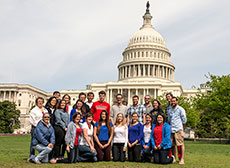Solar Decathlon 2013
Team Capitol DC: The Catholic University of America, George Washington University, and American University
HARVEST HOME is an ecologically responsible house that harvests and replenishes natural resources to forge a deep-rooted connection with the natural environment. A habitat for renewal and regeneration, the house features sophisticated control and biomedical systems to serve returning U.S. military veterans and help them adjust and flourish in a sustainable civilian community.
Design Philosophy
HARVEST HOME is rooted in humanistic, scientific, and spiritual values. The house is designed to calm the mind, body, and spirit through the use of public and private spaces, multiple decks, and rich landscaping. By fostering interaction with the house's energy systems and edible garden, HARVEST HOME promotes a greater appreciation of life, personal strength, and recognition of new life possibilities.
Features
- Reclaimed and recycled materials compose the wall framing, exterior decking, rain screen, interior flooring, and furniture.
- Integrated landscaping balances edible and native plants and blurs the interior and exterior environments to create a healthy and beautiful space.
- Careful attention to natural ventilation enables the house to capture breezes, creating a comfortable environment with abundant fresh air.
- A greywater collection system harvests rainwater and reuses it for landscaping to nurture the edible garden.
- Through a distributed network of activity sensors, the biomedical suite takes measurements unobtrusively to provide physical-therapy data and analyze the living habits of the homeowner.
Technologies
- PV and flat-plate solar thermal systems produce electricity for the house and heat the domestic hot water.
- A unique under-floor heating and cooling distribution system supplies air at floor-level from ductwork connected to a central air handler located in the mechanical closet, allowing less stale air to be mixed with the fresh air and enabling the air handler to work more efficiently.
- An interactive and adaptable shading screen on the large southern glazed façade passively improves energy performance in response to the exterior climate conditions.
- The smart home management system not only monitors and tracks the energy used and saved but also adapts to the occupant's lifestyle—with minimal effort on the occupant's behalf.
Market Strategy
HARVEST HOME is a fully accessible house that facilitates a lifestyle of healing and rejuvenation—a need seen especially among war veterans. Following the Americans with Disabilities Act, the house provides maximum accessibility to its occupants. Designed to foster not only healing but also growth, HARVEST HOME's energy-efficient systems design and direct connection to nature and gardens makes it an inspiring retreat for reconnecting with community and family.
What's Next
After the Solar Decathlon, HARVEST HOME will be donated to Wounded Warrior Homes for use as a transitional home for veterans suffering from post-traumatic stress disorder and traumatic brain injury. The organization already owns a four-bedroom home in Vista, California, that serves as transitional housing for four veterans and their service dogs. Harvest Home will be situated adjacent to this house, with common outdoor spaces connecting and promoting interaction between the homes.
Team Capitol DC will monitor the house to ensure its systems perform as anticipated.
Contact
Kyle Noell
Phone: 301-648-0506
 Enlarge image
Enlarge image
The Catholic University of America, George Washington University, and American University Solar Decathlon 2013 team (Courtesy of the Catholic University of America, George Washington University, and American University Solar Decathlon 2013 team)
The Catholic University of America, George Washington University, and American University audiovisual presentation
Team Deliverables
Neither the United States, nor the Department of Energy, nor the Alliance for Sustainable Energy LLC, nor any of their contractors, subcontractors, or their employees make any warranty, express or implied, or assume any legal liability or responsibility for the accuracy, completeness, or usefulness for any purpose of any technical resources or data attached or otherwise presented here as reference material.



